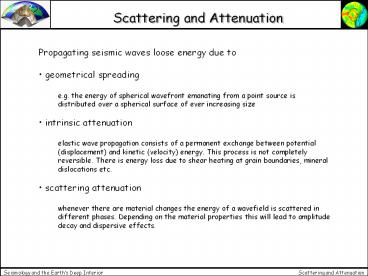Scattering and Attenuation - PowerPoint PPT Presentation
Title:
Scattering and Attenuation
Description:
elastic wave propagation consists of a permanent exchange between potential ... Sandstone. 10. 30. Shale. QS. Qp. Rock Type. Seismology and the Earth's Deep Interior ... – PowerPoint PPT presentation
Number of Views:203
Avg rating:3.0/5.0
Title: Scattering and Attenuation
1
Scattering and Attenuation
- Propagating seismic waves loose energy due to
- geometrical spreading
- e.g. the energy of spherical wavefront emanating
from a point source is distributed over a
spherical surface of ever increasing size - intrinsic attenuation
- elastic wave propagation consists of a permanent
exchange between potential (displacement) and
kinetic (velocity) energy. This process is not
completely reversible. There is energy loss due
to shear heating at grain boundaries, mineral
dislocations etc. - scattering attenuation
- whenever there are material changes the energy of
a wavefield is scattered in different phases.
Depending on the material properties this will
lead to amplitude decay and dispersive effects.
2
Intrinsic attenuation
How can we describe intrinsic attenuation? Let
us try a spring model The equation of motion
for a damped harmonic oscillator is
where e is the friction coefficient.
3
Q
The solution to this system is
so we have a time-dependent amplitude of
and defining
Q is the energy loss per cycle. Intrinsic
attenuation in the Earth is in general described
by Q.
4
Energy loss per cycle
The attenuation parameter Q can be interpreted as
the energy loss per cycle
For a medium with linear stress-strain relation
this can be expressed as
Using the fact that A is proportional to E1/2 .
5
Dispersion effects
What happens if we have frequency independent Q,
i.e. each frequency looses the same amount of
energy per cycle?
- high frequencies more oscillations more
attenuation - low frequencies less oscillations less
attenuation - Consequences
- high frequencies decay very rapidly
- pulse broadening
- In the Earth we observe that Qp is larger than
QS. This is due to the fact that intrinsic
attenuation is predominantly caused by shear
lattice effects at grain boundaries.
6
Pulse Broadening
The effects of a constant Q on a propagating
pulse
7
Q in the Earth
Rock Type Qp QS
Shale 30 10
Sandstone 58 31
Granite 250 70-250
Peridotite Midmantle Lowermantle Outer Core 650 360 1200 8000 280 200 520 0
8
Scattering in random media
How is a propagating wavefield affected by
random heterogeneities?
9
Point Scatterers
How does a point-like perturbation of the elastic
parameters affect the wavefield?
Perturbation of the different elastic parameters
produce characteristic radiation patterns. These
effects are used in diffraction tomography to
recover the perturbations from the recorded
wavefield. (Figure from Aki and Richards, 1980)
10
Correlation length and wavelength
- The governing parameters in this problem are
- The wavelength l of the wavefield (or the
wavenumber k) - The correlation length a
- The propagation distance L
- With special cases
- a L homogeneous region
- a gtgt l ray theory is valid
- a ? l strong scattering effects
11
Scattering Classification
Wave propagation problems can be classified using
the parameters just introduced. This
classification is crucial for the choice of
technique to calculate synthetic
seismograms (Figure from Aki and Richards, 1980)
12
Synthetic seismograms
Synthetic seismograms for a global model with
random velocity perturbations.
When the wavelength is long compared to the
correlation length, scattering effects are
difficult to distinguish from intrinsic
attenuation.
13
Scattering experiment
14
Scattering experiment
15
S - Scattering
16
Scattering on the Moon
The observed wavefield of an impact on the moon
looks very different from similar experiments on
Earth
17
Scattering and Attenuation Summary
Elastic wavefields not only loose energy through
geometrical spreading effects but also through
intrinsic and scattering attenuation. Intrinsic
attenuation is described by the
frequency-dependent attenuation parameter Q(w).
Q describes the energy loss per cycle. In the
Earths crust and mantle Q ranges from 10 to
1000. Any material heterogeneities (point-like,
interfaces, etc.) causes a wavefield to be
scattered. The parameters governing the kind of
scattering are the wavenumber (or wavelength),
the correlation length of the scatterers and the
propagation distance in the scattering medium.
The classification of scattering is important
for the way synthetic seismograms have to be
calculated for a particular problem. Ray theory
is applicable when the correlation length of the
heterogeneities is much larger than the
wavelength. Numerical methods have to be used
when the correlation length is close to the
wavelength.































